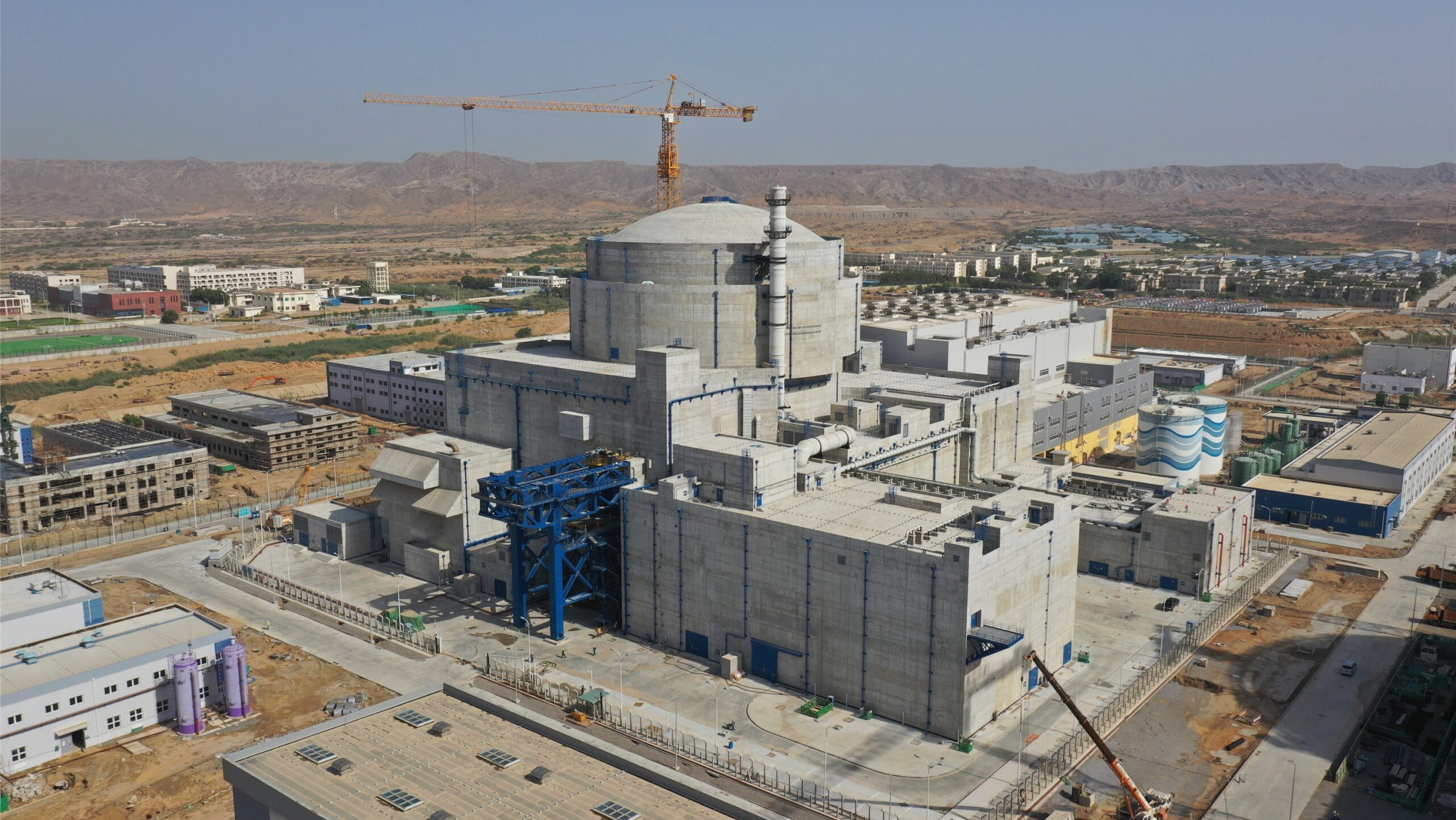Pakistan Breaks Ground on $3.7B Chashma-5 Nuclear Project With China’s Aid
The facility will add 1,200 MW of clean energy by 2030, boosting Pakistan’s energy capacity, hopefully addressing the country's persistent problem of electricity shortages while reducing reliance on fossil fuels
[Islamabad] Pakistan officially began construction on the Chashma Nuclear Power Project Unit-5 (C-5) on Monday, marking a milestone development for the country’s energy sector and the start of construction on its largest nuclear power plant.
China is helping to build this mega project. The Chashma-5 nuclear power project, which is expected to cost $3.7 billion, is expected to be completed and ready for operation by 2030.
The state-run Radio Pakistan reported that “the addition of Chashma-5 will add another 1,200 MW of clean and economical energy to the national grid, increasing nuclear energy to 4,760 MW and boosting socio-economic development.”
Ahsan Iqbal, Pakistan’s federal minister for planning, development, and special initiatives, was among the many prominent attendees at the event, which marked the start of construction with the first concrete pour. Chinese Ambassador to Pakistan Jiang Zaidong, Pakistan Atomic Energy Commission Chairman Dr. Raja Ali Raza Anwar, and other significant dignitaries from China and Pakistan were also in attendance.
The C-5 project stands as a testament to the enduring Pak-China friendship. It is the need of the hour that Pakistan should strive to become a techno-economy.
Addressing the ceremony as the chief guest, Minister Iqbal said, “The C-5 project stands as a testament to the enduring Pak-China friendship,” adding that “it is the need of the hour that Pakistan should strive to become a techno-economy.”
According to Iqbal, “The project will supply affordable, clean, and cheaper electricity to the national grid” and is an example of Pakistan “striving to transform into a technology-driven economy to meet the challenges of the modern era.”
While addressing the ceremony, Chinese Ambassador Zaidong highlighted Chashma-5’s significant impact, noting that during its peak construction phase, it could generate 40,000 jobs, both directly and indirectly. Jiang praised Pakistan’s unique advantages regarding location, language, and human resources, emphasizing how these could synergize with China’s strengths in technology, capital, and market experience and lead to both countries jointly exploring opportunities in third-party markets.
The ambassador further remarked on the strong economic ties between the two nations. Citing recent State Bank of Pakistan statistics, he reported that China accounted for 41% of total direct investment in Pakistan over the past five months despite global economic challenges. Zaidong said this “reflects the vitality and potential of market-driven cooperation between the two countries.”
The Chashma-5 nuclear power project is a major commercial nuclear facility located in Chashma, near Mianwali in Punjab. The facility plays a key role in industrial energy production and operates under the strict monitoring and safeguards of the International Atomic Energy Agency.
Once operational, the new facility will significantly increase Pakistan’s energy supply, helping to address the country’s persistent electricity shortages. Over the past 30 years, Beijing has installed four nuclear power generation units at Chashma, collectively producing around 1,300 megawatts. China supplies enriched uranium for fuel.
This holiday season, give to:
Truth and understanding
The Media Line's intrepid correspondents are in Israel, Gaza, Lebanon, Syria and Pakistan providing first-person reporting.
They all said they cover it.
We see it.
We report with just one agenda: the truth.


According to the available technical data, the C-5 unit will incorporate a third-generation Chinese Hualong pressurized water reactor equipped with advanced active and passive safety systems. Its key features include a double-shell containment structure and a reactor-filtered venting system, ensuring the highest safety standards. With a lifespan of 60 years, the plant is set to play a crucial role in Pakistan’s long-term energy sustainability.
Additionally, once operational, the project is expected to produce a substantial amount of clean and reliable energy, bolstering Pakistan’s efforts to address chronic power shortages and meet its growing electricity demands. The plant is equipped with advanced safety features and cutting-edge technology and is designed to adhere to international nuclear safety and security standards. Nuclear energy currently contributes 8% to Pakistan’s grid, and the addition of C-5 will boost this share, creating jobs, stimulating local economies, and reducing greenhouse gas emissions.
Earlier, the Pakistan Nuclear Regulatory Authority (PNRA) granted the Pakistan Atomic Energy Commission (PAEC) the license to construct the country’s largest nuclear project. A PNRA press release issued last Thursday states, “The license was granted following a comprehensive review and assessment, ensuring all regulatory requirements were met in line with national and international standards.”
Nuclear energy is a clean, efficient, and cost-effective source of electricity that can reduce Pakistan’s reliance on expensive fossil fuels while supporting socioeconomic development.
PAEC Chairman Dr. Raja Ali Raza Anwar told The Media Line, “Nuclear energy is a clean, efficient, and cost-effective source of electricity that can reduce Pakistan’s reliance on expensive fossil fuels while supporting socioeconomic development.”
He noted that “nuclear energy is key to diversifying Pakistan’s energy mix, reducing reliance on imported fuels, and lowering carbon emissions, thereby supporting long-term economic stability and environmental sustainability.”
Pakistan’s energy strategy emphasizes the adoption of renewable energy sources, including hydropower and nuclear energy, to reduce fossil fuel reliance and mitigate climate change.
“Pakistan’s energy strategy emphasizes the adoption of renewable energy sources, including hydropower and nuclear energy, to reduce fossil fuel reliance and mitigate climate change,” Asma Khalid, an independent researcher, former Stimson Center visiting fellow, and an expert on South Asian nuclear politics and security issues, explained to The Media Line.
Khalid noted that “expanding nuclear energy capacity, as demonstrated by projects like Chashma-5, is vital for reducing greenhouse gas emissions and fulfilling international clean energy commitments.”
This has placed immense pressure on economies like Pakistan’s, which allocate a substantial portion of their budgets to fossil fuel imports.
She also highlighted the geopolitical factors influencing energy policies, stating that conflicts in the Middle East and Eastern Europe have significantly driven up hydrocarbon prices. “This has placed immense pressure on economies like Pakistan’s, which allocate a substantial portion of their budgets to fossil fuel imports,” she noted, emphasizing the urgency of transitioning to domestic energy sources.
Discussing China’s role in Pakistan’s energy landscape, Khalid remarked, “China’s contributions through the China-Pakistan Economic Corridor have been instrumental in boosting Pakistan’s indigenous energy capacity, particularly through nuclear and renewable energy projects.”
The civil nuclear program and the ballistic missile program are entirely separate and unrelated domains. Linking the two would be unfounded.
Addressing potential US sanctions on Pakistan’s nuclear missile program and whether it might impact its civil nuclear projects, Khalid clarified: “The civil nuclear program and the ballistic missile program are entirely separate and unrelated domains. Linking the two would be unfounded.”
Pakistan’s energy crisis is rooted in persistent shortages, load shedding, and a heavy reliance on imported fossil fuels, which negatively impact both the economy and the environment. Pakistan’s energy challenges are not just technical but deeply tied to its economic stability and environmental sustainability.
Muhammed Bilal Iftikhar Khan, a Lahore-based defense and geopolitical analyst, confirmed to The Media Line that “Pakistan’s energy crisis is rooted in persistent shortages, load shedding, and a heavy reliance on imported fossil fuels, which negatively impact both the economy and the environment.” He emphasized, “Pakistan’s energy challenges are not just technical but deeply tied to its economic stability and environmental sustainability.”
Khan noted that “C-Five is a game-changer that represents a transformative milestone in addressing these challenges. It significantly enhances the country’s clean energy capacity. By expanding its nuclear power production, Pakistan is not only securing its energy needs but also making a meaningful contribution to global efforts against climate change,” he added.
This is about asserting Pakistan’s sovereignty and technological independence. The inauguration of C-5 sends a clear message to the world that Pakistan is a responsible nuclear power committed to using its capabilities for peaceful and constructive purposes.
Khan argued that this initiative goes beyond energy production. “This is about asserting Pakistan’s sovereignty and technological independence. The inauguration of C-5 sends a clear message to the world that Pakistan is a responsible nuclear power committed to using its capabilities for peaceful and constructive purposes.”
Khan also stressed Pakistan’s right to pursue peaceful nuclear energy for the betterment of its people, stating, “Projects like C-5 reaffirm our commitment to providing sustainable solutions for our population while maintaining our autonomy.”

